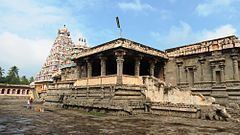Other names Kampaheswarar Temple | Country India Location Thirubuvanam Consort (Parvathi) | |
 | ||
Similar Aavoor Pasupatheeswaram, Mahalingeswarar Temple - Thiruvidaimarudur, Thiru Aadanoor Temple, Adi Kumbeswarar Temple, Aiyarappar temple | ||
The Kampaheswarar Temple is a Hindu temple dedicated to the god Shiva. It is situated in the town of Thirubuvanam on the Mayiladuthurai-Kumbakonam road. Shiva is worshipped as "Kampaheswarar" as he removed the quaking (Skt. Kampa) of a king who was being haunted by a Brahmarakshasa.
Contents
Legend
As per Hindu legend, Shiva is believed to have relieved Kampa (quaking) of a king haunted by evil spirits on account of the king killing a Brahmin by mistake. This led to the name of Kampahisvara. As per another legend, Shiva is believed to have assumed the form to quench the fury of Narasimha, an avatar of Vishnu.
Architecture
The temple follows the Dravidian style of architecture. An unusual feature of the temple is that the vimana is extremely high unlike other Dravidian-style South Indian temples. The architecture of the temple is similar to the Big Temple at Thanjavur, Airavatesvara Temple at Darasuram and Gangaikonda Cholapuram temples. The distinct features of all the temples is the vimana, the structure over the sanctum, being taller than the gateway tower, which is an unusual feature in Dravidian temples. There is a separate shrine for Sarabeswarar and a metal icon of the same deity within the sanctum, which has fine artistic work. Yali, a mythical creature with the face of a lion, which is otherwise considered a symbol of Nayak architecture has its earliest representation in Chola art in the temple, built by the Later Cholas of the 13th century.
History
As per inscriptions found in the south wall of the temple, the shrine was constructed by the Chola king Kulothunga Chola III as a memorial of his successful North Indian campaign. The inscriptions in the shrine of the presiding deity is similar to the one in the outer gopuram (gateway tower), which indicates the building of the temple by Kulottunga-Choladeva. While it is unclear which Kulottunga it is, scholars have placed it at 1176 CE, which is closer to the reign of Kulothunga Chola III, who is believed to have been the last powerful Chola king. There are four inscriptions from Kulothunga Chola in Grantha script. The inscription 189 of 1907, the one on the southern wall of the central shrine, is damaged and mentions Arya Sri-Somanatha. Inscription 190 on the same wall indicates the building operations of Kulothunga Chola. 191, at the entrance of outer gopura, is a duplicate of the 190. On the same gopura, inscription 192 indicates record of king Kulothunga Chola. There are two inscriptions in Tamil from the period of Jatavarman Tribuvanachakravarthin Parakrama Pandyadeva registered by Epigraphy Department in 1911. One of them, 159, registers a contract between the residents of Tribhuvanavirapuram and Kulamangalanadu, who were urkaval (watchmen) of the village. On the same wall, the inscription numbered 160, records a similar contract in the presence of chief Udaiyar Kulasekharadeva.
The Temple
The main deity of the temple is Shiva lingam in the form of Kampaheswarar. There is a separate shrine for Sarabeswarar, a fusion of man, eagle and lion - the deity is believed to have relieved the devas (celestial deities) from the furty of Vishnu in the form of Narasimha after he slayed Hiranyakasibu. A sculpture of Sharbeshwaramurti in the Tribhuvanam temple, a Shiva temple in Tanjore district, in Tamil Nadu is seen with three legs, with body and face of a lion and a tail. It has four human arms, the right upper hand holds axe, noose is held in the lower right hand, the deer in the upper left hand and fire in the lower left hand. Narasimha is shown with eight arms, flaying and struggling under Sharbeshwaramurti’s feet. The shrine has sculptures of Sridevi and Bhudevi, the consorts of Vishnu.
